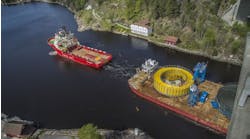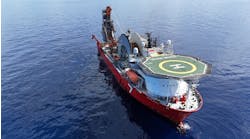Mutineer-Exeter working toward peak output in 2005
Santos' Mutineer-Exeter development is on schedule for first oil in mid-2005. For the Australian operator, peak output from this project will allow it to double its total production. But there are numerous other technical innovations, mainly related to the well architecture. These include:
- First use of dual downhole subsea electric submersible pumps (ESPs) tied back to a new FPSO
- First application of ESPs with Framo's multiphase mud-line booster pumps (MPPs)
- First application of subsea ESPs in two separate well clusters for the same project.
The Mutineer-Exeter fields are 150-km offshore Karratha, northwest Australia, in 160 m of water. Phase 1 of the development involves putting in three wells on Mutineer and one on Exeter, with more to be added during later phases. The oil is sweet and light (43° API), with a gas-oil ratio of 10 cf/bbl and a bubble point of 100 psi.
Santos has contracted the FPSO – a tanker conversion – from Modec under a performance-based service arrangement. This will have capacity of up to 100,000 b/d for production and 930,000 bbl for crude storage with offloads via shuttle tanker in 620,000 packages. As the region is prone to cyclones (up to Category 5 intensity), a single-point system will moor the vessel and allow quick unlatching and sail-away.
Power generating equipment will provide over 25 MW, sufficient for up to 14 ESPs, all designed and engineered by Baker Hughes Centrilift. On both fields, subsea wells will be clustered around a central manifold where incoming flow will be commingled and routed to the Framo 1.2-MW MPPs, two 90-tonne structures measuring 7 x 5 x 7 m. This will be deployed from a diving support vessel with choke and control pods controlled via jumpers from the main umbilical. The latter will also supply control hydraulics, injection chemicals, power, and other controls to the wellheads through connections to the Vetco Gray horizontal trees measuring 4 x 4 x 8 m and weighing 38 tonnes each.
The main 180-mm diameter umbilical will feature static and dynamic (mid-water) sections to respond to vessel motions. Lengths to Mutineer and Exeter will be 3 and 7 km, respectively. A separate, HV-power umbilical will serve to distribute power to the dual ESPs. These systems will provide redundancy downhole and will also function in a wide range of operating conditions as reservoir pressure depletes and water cut increases.
For each dual ESP, the upper module will operate at up to 900 hp, 15,000 b/d ESP, while the lower module – run first – will be rated at 608 hp and 20,000 b/d. All systems will be controlled by 1,300 kVA variable speed drives, designed to maximize operational flexibility, and to ensure that the ESPs' soft start capability develops sufficient torque during applicable step-outs.
The 14 drives were recently shipped out from Aberdeen to the Jurong Shipyard in Singapore on the heavy-lift vessel Annemieke in two purpose-built, A60-rated drive "halls" manufactured by Vertec. The two halls measured 17 m long x 9 m x 9 m for hall 1 and 13 m long x 9 m x 9 m for hall 2, with a combined weight of 350 tonnes. The fire-protected halls will provide more than 1 MW of cooling, heating, ventilation, and air conditioning to protect the drives at their offshore location. The halls are now installed on the Modec Venture II FPSO, with final commissioning and integration testing underway with the work scheduled to be completed by year-end. The vessel should arrive early in the New Year.
null
Over 100,000 ft of ESP cable was delivered to the Santos operations base in Dampier in October, as well as the ESP and completion equipment for the first three wells.
According to Centrilift's project manager for Mutineer-Exeter, Ian Ayling, the production concept here involves initially free-flowing the wells. As reservoir pressure drops, the Framo MPPs will be used as mud line boosters, followed eventually by the ESPs.
"By having the ESP in series," he says, "it has been possible to reduce their motor power requirements, thereby lessening electrical and mechanical stresses on the system and increasing run life potential. There is also the option to bypass the MPPs and produce wells using only the ESPs should this prove preferable from a reservoir/wells stand-point, or if problems should arise with an MPP."
As part of the approval and acceptance process for the ESPs, a series of system integration tests were performed between April and June this year. The first, at Centrilift's base in Tulsa, involved verifying operation of the drives with the selected ESP motors and at the anticipated cable lengths. The second was a stack-up test at ABB's facility in Singapore, which reviewed the installation of the top components from the ESP completion through the ABB wellhead. Finally, a trial installation was mounted on the ESP system and all associated completion components, including the ESP packer, sliding sleeve, and numerous joints above the tree profile.
Centrilift designed and manufactured the ESP management systems (EMSs), which link the pumps to the FPSO's distributed control system, providing performance monitoring and system protection. The EMSs are operational from either the local control mode in the VSD hall or from the vessel's main control room. The protection logic interfaces with the subsea booster pump control systems, the subsea tree control system, and the FPSO DCS, ensuring security of the entire production network, including subsea flowlines.
The EMSs also provide monitoring in real-time of downhole parameters and serve as the main hub of data management in this project. This will allow the data to be used to continuously optimize production and to improve pump run life.




